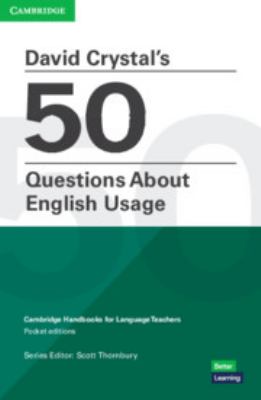
館長分享
English is a global language used by people all over the world and its usage has changed over time. As David Crystal has pointed out in his book “50 Questions about English Usage”, “all languages change and vary”, English is no exception and the change is particularly noticeable due to its social and political history. This book gives answers to some of the questions about usage variation and change in English, which is interesting and enlightening.
In this book, the author categorizes questions in relation to English usage in five sections and provides the answers, including Words and Idioms, Grammar, Pronunciation, Spelling and Punctuation, and Genres. Through answering questions in these five sections with examples as illustration, the author charts the development of English usage. For instance, he uses “a cup” and “a mug” as an example to illustrate the way words interact and change their meaning. Originally, there was only the “cup” which meant a drinking-vessel. “Mug”, referring to a measuring-vessel, came in later and probably in the Middle Ages. In the 18th century, having a “cup” of tea became a mark of high society. On the contrary, mugs came to be associated with lower-class activities as the blue-collar workers used mugs for drinking and they had no fear of spilling. Now, the usage of the two words has become different and social history has played a part.
There is another interesting example showing how usage and culture interact in English words. In the beginning, there was only the word “dinner” which came from French in the 13th century. It meant the main meal of the day. In the late 16th century, the words “luncheon” and ‘’lunch” appeared. Again, the words “dinner” and “lunch” were adopted by different levels of society. Due to the regional and social class variation, many people in the UK used “dinner” for their main meal. They wouldn’t use the word “lunch” at all. But for the professional and fashionable classes, “lunch” was the meal in the middle of the day and “dinner” was the evening meal. The differences have caused confusion in the society. Even nowadays, people still debate “What should we call the meal in the middle of the day, ‘Lunch’ or ‘Dinner’?”
Apart from words, the book also exemplifies the variation and change of pronunciation in English from regional accents to specific ones. The author points out that different pronunciation may mean differently and emphasize different main points. Other than English rhythm, “stress” is also influenced by regional variations as it is easy to find that “stress” is placed later in the word in Scottish and Irish English. Finally, British pronunciation is now infused with “American tone” which can be easily heard among youngsters in Britain nowadays.
This book clearly illustrates why and how usage in English develops and changes. It is a good book for English learners and teachers to learn more about language variation and change.

